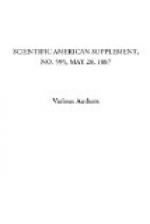The fan engines have cylinders 51/2 in. diameter and 31/2 in. stroke, and make about 1,100 revolutions per minute when at full speed, causing a plenum in the stokeholes of about 6 in. water pressure. Double steam steering gear is fitted, for the forward and aft rudder respectively, and safety from foundering is provided to an unusual degree by the subdivision of the hull into numerous compartments, each of which is fitted with a huge ejector, capable of throwing overboard a great body of water. A body of water equal to the whole displacement of the boat can be discharged in less than seven minutes. There is also a centrifugal pump provided, which can draw from any compartment. The circulating pump is not available, because it has virtually no existence, a very small pump on the same shaft as the centrifugal being used merely to drain the condensers. These last are of copper, cylindrical, and fitted with pipes through which a tremendous current of water is set up by the passage of the boat through the sea. Thus the space and weight due to a circulating pump is saved and complication avoided. The air and feed pumps are combined in one casting let into the engine room floor, quite out of the way, and worked by a crank pin in a small disk on the forward end of the propeller shaft. This is an admirable arrangement, and works to perfection.
The armament of the boat consists of two torpedo tubes in her bows, and a second pair set at a small angle to each—Yarrow’s patent—carried aft on a turntable for broadside firing. There are also two quick firing 3 lb. guns on her deck. The conning tower forward is rifle proof, and beneath it and further forward is fixed the steering engine, and a compressing engine, by which air is compressed for starting the torpedoes overboard and for charging their reservoirs. A small dynamo and engine are also provided for working a search light, if necessary. The accommodation provided for the officers and crew is far in advance of anything hitherto found on board a torpedo boat.
The weather on the morning of Thursday, April 14, was anything rather than that which would be selected for a trial, or indeed any, trip on the Thames. At 11 A.M., the hour at which the boat was to leave Messrs. Yarrow’s yard, Isle of Dogs, the wind was blowing in heavy squalls from the northeast, accompanied by showers of snow and hail. The Italian government was represented by Count Gandiani and several officers and engineers. In all there were about thirty-three persons on board. The displacement of the vessel was as nearly as might be 97 tons. A start was made down the river at 11:15 A.M., the engines making about 180 revolutions per minute, and the boat running at some 111/2 or 12 knots.




